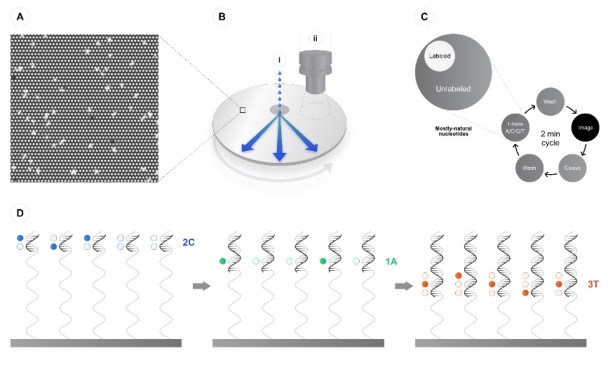Ultima Genomics and Genome Insight Leverage Artificial Intelligence to Offer Cost-Effective Whole Genome Sequencing for Cancer Patients
Ultima Genomics and Genome Insight have forged a partnership with the objective of providing cost-effective whole genome sequencing solutions to individuals with cancer. As part of this collaboration, Genome Insight will join the early access program for Ultima's high-throughput next-generation sequencing (NGS) instrument, the UG 100™. Additionally, Genome Insight will develop an optimized version of its artificial intelligence-powered whole genome bioinformatics solution, tailored to Ultima's sequencing technology. The integration of Genome Insight's proprietary AI-driven bioinformatics with Ultima's affordable sequencing aims to make whole genome sequencing more accessible for cancer patients.

Illustration of the UG 100's open water procedure, showcasing the wafer's microstructured surface. Image Source: Ultima Genomics
Traditionally, cancer—a disease stemming from genomic alterations—has been studied using NGS approaches that focus on targeted panels, which only examine a small portion of the available genomic data. Analyzing the whole genome using artificial intelligence has the potential to enhance our understanding of cancer biology and provide valuable information to physicians when developing personalized treatment strategies for patients. Genome Insight's proprietary AI-powered bioinformatics platform converts a cancer patient's genomic data into medically relevant insights. By optimizing this platform for Ultima's high-throughput, cost-effective sequencing architecture, the partnership aims to provide curated whole genome sequencing reports to patients and physicians at a lower cost than conventional NGS panels.
Young Seok Ju, CEO of Genome Insight, expressed enthusiasm for the partnership with Ultima, emphasizing the role of artificial intelligence in revolutionizing cancer treatment by enabling low-cost whole genome analysis. Ju sees this collaboration as a crucial step in realizing the vision of using AI-powered whole genome sequencing to enhance patient outcomes.
Gilad Almogy, CEO of Ultima Genomics, also highlighted the synergy between the two companies, noting that Genome Insight's focus on artificial intelligence-driven whole genome sequencing aligns with Ultima's mission to address the tradeoffs that scientists and clinicians face in utilizing genomic information.
A growing rivalry with Illumina
The area of genome sequencing is largely dominated by Illumina. In an effort to decrease sequencing costs, Ultima adopts an innovative strategy, influenced by Almogy's expertise in developing optical inspection systems for semiconductors and optical displays, as well as his role in founding Cogenra Solar, a company specializing in photovoltaic solar panels that was acquired by SunPower in 2015.
Ultima and Illumina both make use of a method called "sequencing by synthesis," which involves replicating DNA and employing high-speed cameras to record fluorescent signals that signify the formation of chemical bases; specific software then combines the data into a full genome sequence. In contrast to Illumina, which conducts these reactions within a specialized microfluidics chip known as a flow cell, Ultima's UG 100 instrument analyzes DNA samples on a standard 200 mm semiconductor wafer disc, a cost-effective and easily obtainable alternative.
Additionally, the disc format streamlines the imaging process—whereas capturing images in a flow cell involves constant camera movement in a back-and-forth pattern, Ultima's imaging system remains stationary like a CD player, with the disc spinning beneath it, resulting in a process that is nearly twice as efficient.